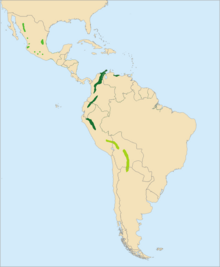Military macaw
| Military macaw | |
|---|---|
 |
|
| A military macaw at the London Zoo. | |
| Scientific classification | |
| Kingdom: | Animalia |
| Phylum: | Chordata |
| Class: | Aves |
| Order: | Psittaciformes |
| Superfamily: | Psittacoidea |
| Family: | Psittacidae |
| Subfamily: | Arinae |
| Tribe: | Arini |
| Genus: | Ara |
| Species: | A. militaris |
| Binomial name | |
|
Ara militaris (Linnaeus, 1766) |
|
 |
|
| Distribution of the 3 subspecies of military macaw | |
The military macaw (Ara militaris) is a large parrot and a medium-sized macaw. Though considered vulnerable as a wild species, it is still commonly found in the pet trade industry. It is found in the forests of Mexico and South America. It gets its name from its predominantly green plumage resembling a military parade uniform.
There are three subspecies, A. m. militaris, A. m. mexicana, and A. m. boliviana. The differences between the subspecies are slight and pertain to minor variations in color and size, generally 70–80 cm (28–31 in), with the militaris subspecies being the smallest and the mexicana being the largest.
The military macaw is 70.5 cm (27.8 in) long on average, 99–110 (33–43 in) across the wings and weighs 900–1,100 grams (2–2.4 lbs). It is mostly green in color with the head a slightly paler shade. It bears a red frontal patch, with a white bare facial area barred with narrow black lines. The flight feathers are blue and the red tail bordered with blue. The large strong beak is grey-black and the iris yellow.
The military macaw appears superficially similar to, and may easily be confused with the somewhat larger great green macaw.
Military macaws live in large flocks and can live about 50–60 years in the wild. They can often be heard long before they are seen. They are a very noisy bird making a variety of loud cracking and shrieking sounds, including a loud kraa-aak.
The military macaw's diet consists of seeds, fruits, nuts, berries, and other vegetation found on treetops in their forests. Their beaks are well adapted for eating various seeds and nuts as they have the ability to break open the hardest of shells with relative ease.
Military macaws will leave their roosts in flocks around dawn and head to their feeding areas. They will also visit heaps of clay known as “macaw licks”. These clay licks are found along riverbanks or sometimes in the interior of the Amazon rainforest. Macaws will flock to there to feed on these clay deposits, which appear to detoxify the poisons found in the seeds and vegetation of the rest of their diet. It is also thought that this clay provides the macaws with dietary salt not available in their normal diet.
The three subspecies will breed at different times. However this probably has more to do with the geographical region they are residing in than anything else. Breeding in the militaris occurs from January to March. The mexicana breeds from April to July and the boliviana breeds in November and December. Military macaws are monogamous and remain with their mates for life. As they fly in large flocks the mates fly together. They will also be found flying in pairs in their feeding and roosting/nesting areas. Females will lay one to two eggs which only she will incubate for a period of approximately 26 days. Military macaws will reach sexual maturity in two to four years.
...
Wikipedia

